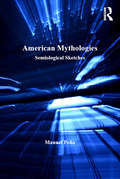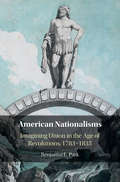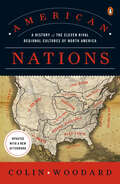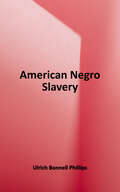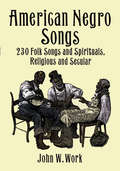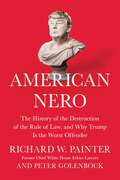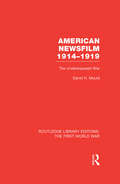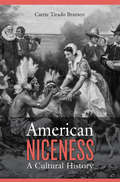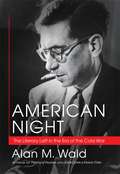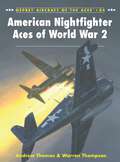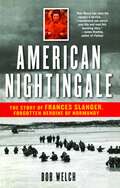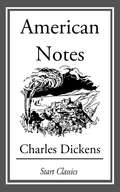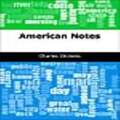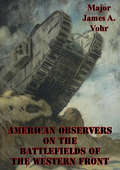- Table View
- List View
American Mythologies: Semiological Sketches
by Manuel PeñaAmerican Mythologies examines eleven myths that form part of the storehouse of present-day American mythologies, elucidating the nature of contemporary myths by investigating their ideological sub-terrain. Grounded in a semiological approach, which explores the displacement of information and the transformation of signs that characterise mythic communication, this book sheds light on the socio-economic, gendered, national and racial interests that lie behind myth-making. Presenting rich case studies from popular culture and public discourse, it demonstrates the manner in which these myths, and American mythology in general, promote the core values of everyday life under capitalism: rugged individualism, the unfettered right to accumulate wealth, the superior moral character of free-enterprise democracy, and its abundant opportunities for every citizen. By the same token, that same mythology negates the corruption endemic to the capitalist social order, an order that also promotes inescapable class, racial, and gender inequalities which confine the majority of Americans to a life of constant economic struggle. A fresh critique of the foundations of American culture, American Mythologies will appeal to those with interests in sociology, social and cultural theory, and cultural and media studies.
American Mythos: Why Our Best Efforts to Be a Better Nation Fall Short
by Robert WuthnowAmerica was built on stories: tales of grateful immigrants arriving at Ellis Island, Horatio Alger-style transformations, self-made men, and the Protestant work ethic. In this new book, renowned sociologist Robert Wuthnow examines these most American of stories--narratives about individualism, immigration, success, religion, and ethnicity--through the eyes of recent immigrants. In doing so, he demonstrates how the "American mythos" has both legitimized American society and prevented it from fully realizing its ideals. This magisterial work is a reflection and meditation on the national consciousness. It details how Americans have traditionally relied on narratives to address what it means to be strong, morally responsible individuals and to explain why some people are more successful than others--in short, to help us make sense of our lives. But it argues that these narratives have done little to help us confront new challenges. We pass laws to end racial discrimination, yet lack the resolve to create a more equitable society. We welcome the idea of pluralism in religion and values, yet we are shaken by the difficulties immigration presents. We champion prosperity for all, but live in a country where families are still homeless. American Mythos aptly documents this disconnect between the stories we tell and the reality we face. Examining how cultural narratives may not, and often do not, reflect the reality of today's society, it challenges readers to become more reflective about what it means to live up to the American ideal.
American Myths in Post-9/11 Music
by Daniele CuffaroAfter September 11, 2001, the void left following the attack on the Twin Towers in the heart of New York was the visible symbol that there was to be a breaking point with the past. The attacks dramatically changed the everyday lives of the American people and the new devastating landscape led people to seek to restore the certainties that had been so suddenly shattered. In doing this, Americans went back to the historical myths in their culture. This book explores the collective memory and historical American myths like, for example, the myth of the innocent nation and the frontier myth, and shows how some of these nationally considered historical truths have not disappeared, but were indeed exhumed in the music produced post-9/11.
American National Identity: Language Patterns and Myths Across the Centuries
by Anna Islentyeva Igor TolochinThis book offers an analytical tool for identifying and analysing the linguistic mechanisms that shape American national identity in public discourses. Drawing on methods from (critical) discourse analysis and corpus linguistics, the authors provide insights into various levels of discourse structures, consider the social and political climate of the US at different stages of its history, trace the diachronic development of the linguistic patterns that shape the American national identity, and conduct a thorough discursive analysis of seminal texts such as The Declaration of Independence and the Preamble to the US Constitution. This book defines the key linguistic markers of the American national identity and provides an insight into how these markers are used to promote various ideologies in the pluralistic world of the contemporary USA. This monograph will be of interest to students and scholars working in fields such as Applied Linguistics, (Critical) Discourse Studies, Cultural Studies, US History and Politics.
American National Security
by Michael J. Meese Suzanne C. Nielsen Rachel M. SondheimerThis classic text provides a rich and nuanced discussion of American national security policymaking.American National Security remains the ideal foundational text for courses in national security, foreign policy, and security studies. Every chapter in this edition has been extensively revised, and the book includes discussion of recent security policy changes in the Trump administration. Highlights include:• An updated look at national security threats, military operations, and homeland security challenges • An analysis of the evolving roles of the president, Congress, the intelligence community, the military, and other institutions involved in national security• A revised consideration of the strengths, limitations, and employment of instruments of national power, including diplomacy, information, economic tools, and armed forces• An exploration of the economic and national security implications of globalization• An enhanced examination of the proliferation of transnational threats, including security challenges in space and in cyberspace• A new assessment of how international, political, and economic trends may change US leadership of the post–World War II international order• A comprehensive update on changing dynamics in key states and regions, including Russia, China, East Asia, the Middle East, South Asia, Europe, Sub-Saharan Africa, and Latin AmericaAn authoritative book that explains US national security policy, actors, and processes in a wide-ranging yet understandable way, American National Security addresses key issues, including challenges to the free and open international order, the reemergence of strategic competition among great powers, terrorism, economic and fiscal constraints, and rapid advances in information and technology.
American Nationalisms
by Benjamin E. ParkAmerica was born in an age of political revolution throughout the Atlantic world, a period when the very definition of 'nation' was transforming. Benjamin E. Park traces how Americans imagined novel forms of nationality during the country's first five decades within the context of European discussions taking place at the same time. Focusing on three case studies - Massachusetts, Pennsylvania, and South Carolina - Park examines the developing practices of nationalism in three specific contexts. He argues for a more elastic connection between nationalism and the nation-state by demonstrating that ideas concerning political and cultural allegiance to a federal body developed in different ways and at different rates throughout the nation. American Nationalisms explores how ideas of nationality permeated political disputes, religious revivals, patriotic festivals, slavery debates, and even literature.
American Nations: A History of the Eleven Rival Regional Cultures of North America
by Colin WoodardAn illuminating history of North America's eleven rival cultural regions that explodes the red state-blue state myth.North America was settled by people with distinct religious, political, and ethnographic characteristics, creating regional cultures that have been at odds with one another ever since. Subsequent immigrants didn't confront or assimilate into an "American" or "Canadian" culture, but rather into one of the eleven distinct regional ones that spread over the continent each staking out mutually exclusive territory.In American Nations, Colin Woodard leads us on a journey through the history of our fractured continent, and the rivalries and alliances between its component nations, which conform to neither state nor international boundaries. He illustrates and explains why "American" values vary sharply from one region to another. Woodard (author of American Character: A History of the Epic Struggle Between Individual Liberty and the Common Good) reveals how intranational differences have played a pivotal role at every point in the continent's history, from the American Revolution and the Civil War to the tumultuous sixties and the "blue county/red county" maps of recent presidential elections. American Nations is a revolutionary and revelatory take on America's myriad identities and how the conflicts between them have shaped our past and are molding our future.From the Hardcover edition.
American Nations: Encounters in Indian Country, 1850 to the Present
by Frederick E. HoxieThis volume brings together an impressive collection of important works covering nearly every aspect of early Native American history, from contact and exchange to diplomacy, religion, warfare, and disease.
American Negra: A Memoir
by Natasha S. AlfordAward-winning journalist Natasha S. Alford grew up between two worlds as the daughter of an African American father and Puerto Rican mother. In American Negra, a narrative that is part memoir, part cultural analysis, Alford reflects on growing up in a working-class family from the city of Syracuse, NY.In smart, vivid prose, Alford illustrates the complexity of being multiethnic in Upstate New York and society’s flawed teachings about matters of identity. When she travels to Puerto Rico for the first time, she is the darkest in her family, and navigates shame for not speaking Spanish fluently. She visits African-American hair salons where she’s told that she has “good” hair, while internalizing images that as a Latina she has "bad” hair or pelo malo.When Alford goes from an underfunded public school system to Harvard University surrounded by privilege and pedigree, she wrestles with more than her own ethnic identity, as she is faced with imposter syndrome, a shocking medical diagnosis, and a struggle to define success on her own terms. A study abroad trip to the Dominican Republic changes her perspective on Afro-Latinidad and sets her on a path to better understand her own Latin roots.Alford then embarks on a whirlwind journey to find her authentic voice, taking her across the United States from a hedge fund boardroom to a classroom and ultimately a newsroom, as a journalist. A coming-of-age story about what it's like to live at the intersections of race, culture, gender, and class, all while staying true to yourself, American Negra is a captivating look at one woman’s experience being Negra in the United States. As the movement to highlight Afro-Latin identity and overlooked histories of the African diaspora grows, American Negra illustrates the diversity of the Black experience in the larger fabric of American society.
American Negro Slavery: A Survey of the Supply, Employment, and Control of Negro Labor as Determined by the Plantation Regime
by Ulrich Bonnell PhillipsOriginally published in 1918, Ulrich Bonnell Phillips?s American Negro Slavery was widely hailed upon publication as the most comprehensive and accurate examination of enslaved Africans in the South by an academic historian. In the 1950s, however, a new generation of historians?led by Kenneth Stamp?challenged many of Phillips?s inaccurate and racist views about slavery. While many historians today acknowledge that American Negro Slavery is a pioneering work, most agree that Phillips?s misunderstandings, misinterpretations, and overt racism profoundly diminish his conclusions. This 1966 edition includes a foreword by Eugene D. Genovese, author of numerous academic works on slavery, including the Bancroft Prize-winning Roll, Jordan, Roll: The World the Slaves Made (1974).
American Negro Songs: 230 Folk Songs and Spirituals, Religious and Secular
by John W. WorkFrom joyous gospel to deeply felt blues, this wonderful collection contains vintage songs sung and played through the years by black Americans — at work, in church, and for pure entertainment. Included are spirituals, blues, work songs, and a variety of social and dance songs.This important volume was originally compiled in 1940 by Dr. John W. Work, the noted musicologist affiliated with Fisk University and the celebrated Fisk Jubilee Singers. In it, he discusses the origins and history of black American folk music, the influence of slavery and African cultures, and the lyric significance of such much-loved songs as "Swing Low, Sweet Chariot," Steal Away to Jesus," "Lord, I Want to Be a Christian," and "John Henry." These informative notes lead up to the heart of the book: the complete words and music for 230 religious and secular songs, including "Study War No More," "Keep Me from Sinking Down," "You May Bury Me in the East," "Rock of Ages," "Go Tell It on the Mountain," and many others.This is an indispensable treasury of music for singers, musicians and all readers seeking a comprehensive sourcebook of black American folk music. It will be equally welcomed at parties, family get-togethers, sing-alongs, church events, and other gatherings where people want to play and sing these classic folk songs that are an integral part of American musical history.
American Nero: The History of the Destruction of the Rule of Law, and Why Trump Is the Worst Offender
by Peter Golenbock Richard PainterDonald Trump is eroding the rule of law! We've heard it said many times, and we can feel it in our guts. But what does "rule of law" really mean? And what happens when it breaks down? From Richard Painter, a senate candidate and law professor who served as White House chief ethics counsel under President George W. Bush, and New York Times bestselling author Peter Golenbock, American Nero is an in-depth exploration the rule of law—the legal bedrock on which this country was founded. Painter and Golenbock present a clear description of rule of law—arguably the single most important principle underlying our civilization. They also describe the abuses of power that have occurred throughout our nation's history. Beginning in Puritan New England with the infamous Salem Witch Trials, American Nero makes vivid stops at The Red Scare of the 1920s, Japanese-American internment, the McCarthy Era, and, much more recently, President Trump's attempt to violate the First Amendment by banning Muslims from entering the US. While Trump is not the first offender, he is arguably the most blatant, and this unflinchingly honest and insightful work presents in devastating detail the ways in which our current president has trampled the rule of law with his attacks on the freedom of the press, the independence of the judiciary, and the autonomy of the justice department. This is not a book about right vs. left —instead, it is about the rule of law, a principle that transcends partisan politics, and how vital it is to the survival of our country. This book serves as a call-to-action, looking ahead to a brighter future for our country, one where citizens and officials alike protect our rights and honor their responsibilities. Timely and revealing, American Nero shares the lessons of history and lays the framework for returning to a society that respects the rule of law—an America that is consistent with our Founding Fathers' vision of a genuinely free nation.
American Newsfilm 1914-1919: The Underexposed War (Routledge Library Editions: The First World War)
by David H. MouldThe First World War was the first conflict in which film became a significant instrument of propaganda. For the United States, the war had two distinct phases: from August 1914 to April 1917, America was officially a neutral country; after April 1917 the United States was in the war, providing men, money and munitions for the Allies. These two phases are mirrored in the newsreels and documentary films shown in the United States. This volume starts by examining the background to the war for the movie industry – the coverage of previous conflicts and the growth of the newsreel. It examines the experiences of American cameramen who worked in the war zone: their efforts to gain access to the front, to overcome problems ranging from unreliable equipment to poor lighting conditions to evading censorship and how this shaped the coverage of the war.
American Niceness: A Cultural History
by Carrie Tirado BramenThe cliché of the Ugly American—loud, vulgar, materialistic, chauvinistic—still expresses what people around the world dislike about their Yankee counterparts. Carrie Tirado Bramen recovers the history of a different national archetype—the nice American—which has been central to ideas of American identity since the nineteenth century.
American Nietzsche: A History of an Icon and His Ideas
by Jennifer Ratner-RosenhagenIf you were looking for a philosopher likely to appeal to Americans, Friedrich Nietzsche would be far from your first choice. After all, in his blazing career, Nietzsche took aim at nearly all the foundations of modern American life: Christian morality, the Enlightenment faith in reason, and the idea of human equality. Despite that, for more than a century Nietzsche has been a hugely popular—and surprisingly influential—figure in American thought and culture. In American Nietzsche, Jennifer Ratner-Rosenhagen delves deeply into Nietzsche's philosophy, and America’s reception of it, to tell the story of his curious appeal. Beginning her account with Ralph Waldo Emerson, whom the seventeen-year-old Nietzsche read fervently, she shows how Nietzsche’s ideas first burst on American shores at the turn of the twentieth century, and how they continued alternately to invigorate and to shock Americans for the century to come. She also delineates the broader intellectual and cultural contexts within which a wide array of commentators—academic and armchair philosophers, theologians and atheists, romantic poets and hard-nosed empiricists, and political ideologues and apostates from the Left and the Right—drew insight and inspiration from Nietzsche’s claims for the death of God, his challenge to universal truth, and his insistence on the interpretive nature of all human thought and beliefs. At the same time, she explores how his image as an iconoclastic immoralist was put to work in American popular culture, making Nietzsche an unlikely posthumous celebrity capable of inspiring both teenagers and scholars alike. A penetrating examination of a powerful but little-explored undercurrent of twentieth-century American thought and culture, American Nietzsche dramatically recasts our understanding of American intellectual life—and puts Nietzsche squarely at its heart.
American Night
by Alan M. WaldAmerican Night, the final volume of an unprecedented trilogy, brings Alan Wald's multigenerational history of Communist writers to a poignant climax. Using new research to explore the intimate lives of novelists, poets, and critics during the Cold War, Wald reveals a radical community longing for the rebirth of the social vision of the 1930s and struggling with a loss of moral certainty as the Communist worldview was being called into question. The resulting literature, Wald shows, is a haunting record of fracture and struggle linked by common structures of feeling, ones more suggestive of the "negative dialectics" of Theodor Adorno than the traditional social realism of the Left. Establishing new points of contact among Kenneth Fearing, Ann Petry, Alexander Saxton, Richard Wright, Jo Sinclair, Thomas McGrath, and Carlos Bulosan, Wald argues that these writers were in dialogue with psychoanalysis, existentialism, and postwar modernism, often generating moods of piercing emotional acuity and cosmic dissent. He also recounts the contributions of lesser known cultural workers, with a unique accent on gays and lesbians, secular Jews, and people of color. The vexing ambiguities of an era Wald labels "late antifascism" serve to frame an impressive collective biography.
American Nightfighter Aces of World War 2
by Chris Davey Warren ThompsonThe Americans lagged behind their European contemporaries in military aviation in the late 1930s, and it took the Battle of Britain to awaken an isolated America to the necessity of having aircraft that could defend targets against nighttime attack by bomber aircraft. With the help of the RAF, the importance of creating such a specialized fighter force was given top priority. This book examines the numerous aircraft types that were used by the US in this role, beginning with the early 'stop-gap' conversions like the TBM Avenger, Lockheed Ventura and the A-20 Havoc (P-70). It goes on to detail the combat history of the newer and radar equipped Hellcats, Corsairs and Black Widows that were designed to seek out enemy aircraft (both German and Japanese) in Europe, the Mediterranean and the Pacific. It was these aircraft that registered most of the kills made by the Navy, Marine Corps and USAAF in 1944-45. Finally there are additional accounts from the American pilots who spent time on the frontline on exchange tours with the RAF in the ETO/MTO, learning the intricacies of flying radar-equipped fighters like the Mosquito and Beaufighter at night, prior to the USAAF taking receipt of the much-delayed P-61. With full color profiles and rare photographs, this is an absorbing account of an often underestimated flying force: the American Nightfighters.
American Nightingale: The Story of Frances Slanger, Forgotten Heroine of Normandy
by Bob WelchOf the 350,000 American women in uniform during World War II, none instilled more hope in American GIs than Frances Slanger. In Army fatigues and helmet she splashed ashore with the first nurses to hit the Normandy beach in June 1944. Later, from a storm-whipped tent amid the thud of artillery shells, she wrote a letter to Stars and Stripes newspaper that would stir the souls of thousands of weary soldiers. Hundreds wrote heartfelt responses, praising Slanger and her fellow nurses and honoring her humility and patriotism. But Frances Slanger never got to read such praise. She was dead, killed the very next day when German troops shelled her field hospital, the first American nurse to die in Europe after the landing at Normandy. Frances Slanger was a Jewish fruit-peddler's daughter who survived a chilling childhood in World War I-torn Poland and immigrated to America at age seven. Inspired by memories of her bitter past and a Nazi-threatened future, she defied her parents' wishes by becoming a nurse and joining the military. A woman of great integrity and courage, she was also a passionate writer and keeper of chapbooks. This is the story of her too brief life.
American Nightmare: The History of Jim Crow
by Jerrold M. Packard“A very powerful and unsettling story of our nation’s century-long ‘pogrom’ by vengeful white Southerners against their black neighbors.” —The Washington TimesFor a hundred years after the end of the Civil War, a quarter of all Americans lived under a system of legalized segregation called Jim Crow. Together with its rigidly enforced canon of racial “etiquette,” these rules governed nearly every aspect of life—and outlined draconian punishments for infractions.The purpose of Jim Crow was to keep African Americans subjugated at a level as close as possible to their former slave status. Exceeding even South Africa’s notorious apartheid in the humiliation, degradation, and suffering it brought, Jim Crow left scars on the American psyche that are still felt today. American Nightmare examines and explains Jim Crow from its beginnings to its end: how it came into being, how it was lived, how it was justified, and how, at long last, it was overcome only a few short decades ago. Most importantly, this book reveals how a nation founded on principles of equality and freedom came to enact as law a pervasive system of inequality and virtual slavery.Although America has finally consigned Jim Crow to the historical graveyard, Jerrold Packard shows why it is important that this scourge—and an understanding of how it happened—remain alive in the nation’s collective memory.“Sweeping history . . . Packard compels us to remember that one cannot effectively confront the challenges posed by contemporary race relations without recognizing the agonies of the American past.” —The Christian Science Monitor
American Notes
by Charles DickensWhen Charles Dickens set out for America in 1842 he was the most famous man of his day to travel there - curious about the revolutionary new civilization that had captured the English imagination. His frank and often humorous descriptions cover everything from his comically wretched sea voyage to his sheer astonishment at the magnificence of the Niagara Falls, while he also visited hospitals, prisons and law courts and found them exemplary. But Dickens's opinion of America as a land ruled by money, partly built on slavery, with a corrupt press and unsavoury manners, provoked a hostile reaction on both sides of the Atlantic. American Notes is an illuminating account of a great writer's revelatory encounter with the New World.
American Notes
by Charles DickensCharles Dickens was the most famous of many travelers of his time who journeyed to America, curious about the revolutionary new civilization that had captured the English imagination. His frank, often humorous descriptions in his 1842 account cover everything from his uncomfortable sea voyage to an ecstatic narrative of his visit to Niagara Falls. Yet Dickens is also critical of American society, its preoccupation with money, and reliance on slavery, as well as the rude, unsavory manners of Americans and their corrupt press. Above all, American Notes is a lively chronicle of what was for Dickens an illuminating encounter with the New World.
American Notes
by Charles DickensTrajectory presents classics of world literature with 21st century features! Our original-text editions include the following visual enhancements to foster a deeper understanding of the work: Word Clouds at the start of each chapter highlight important words. Word, sentence, paragraph counts, and reading time help readers and teachers determine chapter complexity. <P> <P> Co-occurrence graphs depict character-to-character interactions as well character to place interactions. Sentiment indexes identify positive and negative trends in mood within each chapter. Frequency graphs help display the impact this book has had on popular culture since its original date of publication. Use Trajectory analytics to deepen comprehension, to provide a focus for discussions and writing assignments, and to engage new readers with some of the greatest stories ever told. "American Notes" by Charles Dickens is an account of Dickens' five month trip across America and Canada in 1842. Read this story to get a humorous and honest portrayal of life in America in the 19th century!
American Nursing: A History of Knowledge, Authority, and the Meaning of Work
by Patricia D'AntonioFirst Place, History and Public Policy, 2010 American Journal of Nursing Book of the Year AwardsThis new interpretation of the history of nursing in the United States captures the many ways women reframed the most traditional of all gender expectations—that of caring for the sick—to create new possibilities for themselves, to renegotiate the terms of some of their life experiences, and to reshape their own sense of worth and power. For much of modern U.S. history, nursing was informal, often uncompensated, and almost wholly the province of female family and community members. This began to change at the end of the nineteenth century when the prospect of formal training opened for women doors that had been previously closed. Nurses became respected professionals, and becoming a formally trained nurse granted women a range of new social choices and opportunities that eventually translated into economic mobility and stability. Patricia D'Antonio looks closely at this history—using a new analytic framework and a rich trove of archival sources—and finds complex, multiple meanings in the individual choices of women who elected a nursing career. New relationships and social and professional options empowered nurses in constructing consequential lives, supporting their families, and participating both in their communities and in the health care system. Narrating the experiences of nurses, D'Antonio captures the possibilities, power, and problems inherent in the different ways women defined their work and lived their lives. Scholars in the history of medicine, nursing, and public policy, those interested in the intersections of identity, work, gender, education, and race, and nurses will find this a provocative book.
American Oasis: Finding the Future in the Cities of the Southwest
by Kyle PaolettaAn expansive and revelatory historical exploration of the multicultural, water-seeking, land-destroying settlers of the most arid corner of North America, arguing that in order to know where the United States is going in the era of mass migration and climate crisis we must understand where the Southwest has already beenAlbuquerque. Phoenix. Tucson. El Paso. Las Vegas. Iconic American cities surrounded by desert and rust. Teeming metropolises that seem to exist independently of the seemingly inhospitable and arid landscape that surrounds them, belying the rich insight they offer into American stories of migration, industry, bloodshed, and rebirth. Charting a geographic path through America's largest and hottest deserts, acclaimed journalist Kyle Paoletta maps the past and future of these cities, and the many other settlements from rural town to urban sprawl that make up the region that has come to be called &“the American Southwest.&” Weaving together the stories of immigrants and indigenous populations, American Oasis pulls back the layers of settlement, sediment, habit, and effect that successive empires have left on the region, from the Athapascan, Diné, Tewa, Apache, and Comanche, to the Spanish, Mexican, and, finally, American. As Paoletta&’s journey into the Southwest&’s history becomes inextricably linked to an exploration of its dependency on water, he begins to ask: where, ultimately, will cities like Las Vegas and Phoenix find themselves once the Colorado River and its branches dry up? Richly reported and sweeping in its history, American Oasis is the story of what one iconic region&’s past can tell us about our shared environmental and cultural future.
American Observers On The Battlefields Of The Western Front
by Major James A. Vohr USMCAlthough during World War I the United States employed observers on the battlefields of the Western Front, the information they provided lacked the substance and conclusions required to evolve the tactical doctrine of the American Expeditionary Forces (AEF). In initial engagements, the AEF was largely forced to rely, with predictable negative outcome, upon outdated concepts founded largely upon the prejudices of the Army's leadership.In August of 1914 the United States Army and Marine Corps demonstrated strong foresight, considering the isolationist perspective of the nation, in detailing officers to the battlefields of Europe. These officers were given little guidance, but their mission was clearly to report on military actions and developments in what was becoming the largest struggle in history. A significant military development of World War I noted by the U.S. was the advance of offensive infantry tactics to cope effectively with the characteristics and lethality of the modern battlefield.The United States, with a two and one-half year opportunity to observe tactics prior to the engagement of the AEF, arguably should have benefited from the experience of others. However, this was not the case. The AEF in its initial engagements, performed much as its European counterparts did at the onset of the war. Eventually the AEF performance improved, but only as U.S. soldiers and Marines gained personal battlefield experience.
